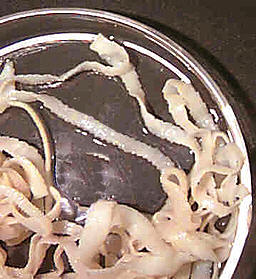Tapeworm
 What kind of problems do tapeworms cause for the dog?
What kind of problems do tapeworms cause for the dog?
Tapeworms are not highly pathogenic (harmful) to your dog. They may cause debilitation and weight loss when they occur in large numbers. Sometimes, the dog will scoot or drag its anus across the ground or carpet because the segments are irritating to the skin in this area. The adult worm is generally not seen, but the white segments which break away from the tapeworm and pass outside the body rarely fail to get an owner's attention!
Occasionally, a tapeworm will release its attachment in the intestines and move into the stomach. This irritates the stomach, causing the dog to vomit the worm. When this happens, a worm several inches in length will be seen.
How is tapeworm infection diagnosed?
An infection with Dipylidium is usually diagnosed when the white, mobile segments are seen crawling on your dog or in the stool. Tapeworms are not usually detected by the routine fecal examination performed by the veterinarian. Because of this, veterinarians depend on the owner to notify them of possible tapeworm infection in the dog.
Echinococcus infections are harder to diagnose than the tapeworm caused by fleas because the segments are small and not readily seen.
How are the tapeworms treated?
Treatment is simple and, fortunately, very effective. A drug which kills tapeworms is given, either orally or by injection. It causes the tapeworm to dissolve within the intestines. Since the worm is usually digested before it passes, it is not visible in your dog's stool. These drugs should not cause vomiting, diarrhea, or any other adverse side-effects.
Control of fleas is very important in the management and prevention of tapeworm infection. Flea control involves treatment of your dog, the indoor environment and the outdoor environment where the dog resides. If the dog lives in a flea-infested environment, reinfection with tapeworms may occur in as little as two weeks. Because the medication which treats tapeworm infection is so effective, return of the tapeworms is almost always due to reinfection from the environment.
How do I tell tapeworms from pinworms?
Tapeworms and pinworms look very similar. However, contrary to popular belief, pinworms do not infect dogs or cats. Any worm segments seen associated with dogs are due to tapeworms. Children who get pinworms do not get them from dogs or cats.
Echinococcus tapeworms are of more concern. These tapeworms cause very serious disease when humans become infected. Hunters and trappers in the north central United States and south central Canada may be at risk for infection by this worm if strict hygiene is not observed. Rodent control and good hygiene are important in preventing the spread of this disease to humans. As with the more common tapeworm, infection with Echinococcus is infrequent but possible.
What can be done to control tapeworm infection in dogs and to prevent human infection?
- Effective flea control is important.
- Prompt deworming should be given when parasites are detected; periodic deworming may be appropriate for pets at high risk for reinfection.
- All pet feces should be disposed of promptly, especially in yards, playgrounds, and public parks.
- Strict hygiene is important, especially for children.
- Do not allow children to play in potentially contaminated environments.
Return to Articles